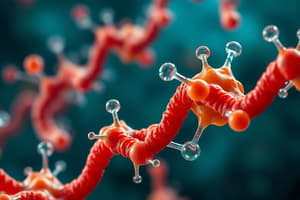Podcast
Questions and Answers
What is the primary function of enzymes in biochemical reactions?
What is the primary function of enzymes in biochemical reactions?
- To consume the reactants in the reaction
- To increase the rate of chemical reaction (correct)
- To decrease the energy of activation
- To alter the reactants in the reaction
What is the term for the area on the enzyme where the substrate binds?
What is the term for the area on the enzyme where the substrate binds?
- Catalytic site
- Active site (correct)
- Reaction site
- Binding site
What is the term for the enzyme without its non-protein component?
What is the term for the enzyme without its non-protein component?
- Active enzyme
- Apoenzyme (correct)
- Holoenzyme
- Inactive enzyme
What is the role of enzymes in biochemical reactions?
What is the role of enzymes in biochemical reactions?
What happens to enzymes during a biochemical reaction?
What happens to enzymes during a biochemical reaction?
What is the term for the substance on which an enzyme begins its action?
What is the term for the substance on which an enzyme begins its action?
What is the characteristic of a competitive inhibitor molecule?
What is the characteristic of a competitive inhibitor molecule?
Where does an allosteric inhibitor molecule bind to the enzyme?
Where does an allosteric inhibitor molecule bind to the enzyme?
What is the result of an allosteric inhibitor binding to the enzyme?
What is the result of an allosteric inhibitor binding to the enzyme?
What is the term used to describe the phenomenon of allosteric inhibition?
What is the term used to describe the phenomenon of allosteric inhibition?
What is the characteristic of an allosteric inhibitor molecule?
What is the characteristic of an allosteric inhibitor molecule?
What is the nature of allosteric inhibition?
What is the nature of allosteric inhibition?
What is the primary role of enzymes in a reaction?
What is the primary role of enzymes in a reaction?
What is the energy barrier between reactants and products called?
What is the energy barrier between reactants and products called?
Which theory proposes that the active site of the enzyme is complementary in shape to the substrate?
Which theory proposes that the active site of the enzyme is complementary in shape to the substrate?
What is the result of the enzyme-substrate complex forming?
What is the result of the enzyme-substrate complex forming?
What is the function of the active site of an enzyme?
What is the function of the active site of an enzyme?
What is the primary difference between the lock and key theory and the induced fit theory?
What is the primary difference between the lock and key theory and the induced fit theory?
What is the relationship between the rate of enzyme action and the concentration of enzyme, provided there is a sufficient supply of substrate and constant conditions?
What is the relationship between the rate of enzyme action and the concentration of enzyme, provided there is a sufficient supply of substrate and constant conditions?
At what point does the reaction rate become maximal?
At what point does the reaction rate become maximal?
What is the temperature range at which the optimum temperature is reached in humans?
What is the temperature range at which the optimum temperature is reached in humans?
What is the reason for the increase in the rate of reaction with an increase in temperature?
What is the reason for the increase in the rate of reaction with an increase in temperature?
What happens to the reaction rate when the substrate concentration increases beyond the point of maximum activity?
What happens to the reaction rate when the substrate concentration increases beyond the point of maximum activity?
What is the term for the maximum rate of reaction that can be achieved by an enzyme?
What is the term for the maximum rate of reaction that can be achieved by an enzyme?
What does the enzyme classification number EC: 2.7.1.1 represent?
What does the enzyme classification number EC: 2.7.1.1 represent?
Which enzyme is represented by the code number EC: 1.1.1.1?
Which enzyme is represented by the code number EC: 1.1.1.1?
What is the specific name of the enzyme with EC: 2.7.1.1?
What is the specific name of the enzyme with EC: 2.7.1.1?
What is the biochemical activity of oxidoreductases?
What is the biochemical activity of oxidoreductases?
What is the reaction catalyzed by Hexokinase?
What is the reaction catalyzed by Hexokinase?
Which of the following enzymes is an example of a transferase?
Which of the following enzymes is an example of a transferase?
Flashcards are hidden until you start studying




